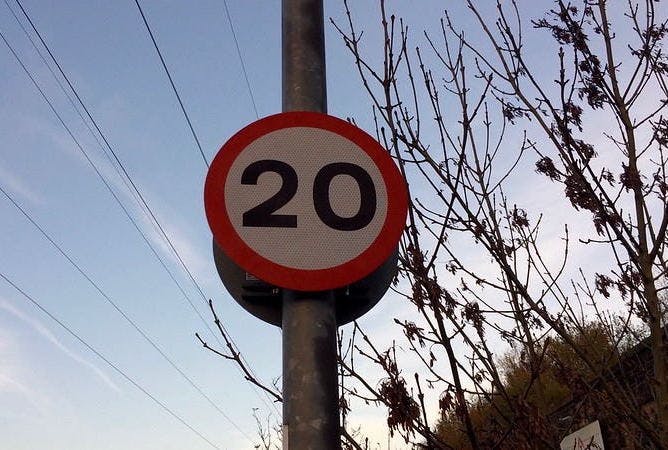
As part of the ongoing '20 is Plenty' campaign, more and more residential roads have reduced from 30 to 20mph in recent years in an effort to decrease casualties, increase active travel and improve the environment. But from 23rd September 2023, Wales is going the whole hog—instead of the current national speed limit of 30mph on restricted roads, the default limit will drop to 20mph. And, today, we're going to take a look at how and why this change is being made.
Does '20 is Plenty' mean all 30mph roads change to 20mph?
The '20 is Plenty' change will be made to restricted roads, which are roads that have street lighting at least every 183 metres apart. They tend to be found on urban routes or running through villages: built up areas, in other words. These are the places where it’s more likely to find pedestrians and cyclists—or where people might want to walk or cycle, if the road was made safer.
Although the default speed limit is set to drop, councils will have the right to retain limits of 30mph on roads that will be known as ‘exceptions’. They will consult with residents, and look at each road’s layout and use, to come to a final conclusion about its speed limit.
Some of the exceptions are already in place. During a pilot phase of the new scheme, eight Welsh communities were selected to trial the new default 20mph roads. But things didn’t go altogether to plan: following backlash from residents and commuters in Severnside, Monmouthshire, several routes were switched back to 30mph.
Motorists were unimpressed with increased congestion, aggressive driving and risky overtaking. They felt that, far from making the roads safer, the decreased speed limit seemed to have done the opposite.
Following the decision to revert some routes back to the old speed limit, the Welsh government reminded constituents that:
"The new legislation will not apply a blanket speed limit on all roads, it will simply make the default limit 20mph. Ultimately, it will be down to local authorities to decide which roads should retain the 30mph limit in consultation with their residents."
And in some places, there will be buffer zones of 30 or 40mph, before road users get to 20mph roads.
Why is the 20mph speed limit being imposed?
Welsh government departments are all responsible for considering the Wellbeing of Future Generations Act when dreaming up new policies, and the objectives of the 20mph default limit are consistent with this legislation: to create a better country to live in. They commissioned a task force to look into the details of implementing 20mph speed limits on residential roads. The subsequent report considered the arguments for the scheme. Here are the main ones.
Save lives, livelihoods and money
It’s almost impossible to talk about a reduction in collisions and casualties without also taking into account the consequential impact on the economy. The Welsh government is really hoping for a double whammy, and the research supports its ambitions: the 20mph initiative should save both lives and money.
With nearly 1 in 3 collisions leading to death or injury happening on slow-speed roads (those with 30mph limits or less), it’s pretty clear more can be done to prevent accidents. Stopping distances at 20mph are almost half those at 30mph: 12 metres compared to 23. Or, to put it in terms of fatalities, you have an 8% chance of dying from injuries when hit at 30mph—but only a 1.5% risk if the driver is doing 20. 100 lives are expected to be saved over ten years with the new laws. And if that doesn’t all that high, it’s because it’s only part of the story.
With fewer accidents causing serious injuries, there is also a huge saving to be had by the NHS in treating casualties. There are wider implications for the economy as well. Legal support, insurance payouts, time out of work and the need for care also factor into the sums, as well as the impact on peoples’ ability to contribute to the workforce.
So although the initial outlay is projected to cost over £30m, the savings are expected to exceed this three times over—just in its first year.
Encourage physical activity

It isn’t just objective risk, but the perception of danger, which stops many people walking or cycling—or letting their children walk or cycle. There is short-term evidence, from similar schemes in Bristol and Edinburgh, that more people choose ‘active travelling’ in 20mph zones—and studies across Europe seem to back this up: slower speed limits encourage cyclists to take to the roads.
Longer term, the government is very much hoping that those who claim they would be more likely to walk or bike if the speed limit was lowered will honour their pledges. This will help children, in particular, to become more active. And it’s hoped that these habits will remain with them for life—potentially improving health at a societal level.
Increase social cohesion
Social connectivity is known to improve health and wellbeing; walking and cycling provide opportunities for human interaction. It’s difficult to measure the exact impact of a scheme like this, but the task force pointed out that a potential for social cohesion could only be a good thing.
Improve the environment
The environmental impact of lower speed limits are twofold:
- Slower vehicles release fewer emissions
- Safer roads for pedestrians and cyclists may mean people drive less overall
The report acknowledges that it isn’t yet known whether the speed reduction will directly contribute to better air quality. But it does point to evidence that suggests 20mph roads are linked to either negligible changes or slight improvements in pollution levels.
How will the new speed limits be enforced?

The Welsh government isn’t under any illusions that motorists will automatically cut down to 20mph without encouragement, and recognise that a major behavioural shift will need to take place. They’re also aware that enforcement is critical to the scheme’s success
Since most roads that are going to be subjected to the speed reduction have already been built, it won’t be practical for many of them to be re-engineered to feature traffic calming measures such as chicanes or narrowings.
However, evidence suggests that even a small reduction of speed will improve safety on the road immediately. These reductions should increase with time: the government is counting on it becoming more normalised to drive at slower speeds in residential areas, and will implement public campaigns to educate people as to the benefits of doing so.
They’re going to be focusing on getting companies that operate vehicle fleets on board, too: these drivers can act as ‘pace vehicles’ and slow down other traffic. They also highlight the increase of vehicles with Intelligent Speed Assistance, which use GPS data and speed sign recognition to automatically restrict engine power. More and more cars will feature this technology as the years pass, and should help to keep drivers’ speeds in check.
And finally, speed cameras—particularly average speed checks and mobile cameras—will be used on higher risk routes to deter and detect speeders. These will mostly be supplied by GoSafe, who are largely responsible for enforcing speed limits across Wales. The current Community Speedwatch programme, whose volunteers can refer repeat offenders to the police, will continue—and of course, the police themselves will play a part in ensuring compliance with the new rules.
What is the reaction in Wales?

It’s fair to say people across Wales have mixed views on the plans. The government points to a survey saying that most people support the speed limit reduction, most prominently those who are parents, women, or in the middle age bracket.
But there have been claims that the questionnaire was “skewed". Resident Phil Hill told WalesOnline that:
“We were asked if we felt it was safer for children and whether we thought people had less of a chance of being killed at lower speeds. Of course we understand that and that’s why we support it near the schools and where people are walking a lot."
But he—along with many others—contested the need for reduced speed limits on roads where there are fewer pedestrians, and are unconvinced that motorists will adhere to the new limits. Around 46,000 people (of a population of over 3 million) have signed a petition contesting the proposed changes, and the Conservative shadow transport minister, Natasha Asghar, has called for money to be poured into public transport instead.
On the other hand, the research suggests that most people are in favour of 20mph limits around where they live—but also think they hold a minority view. It could be the case that pejorative opinions are gaining the most traction online, and therefore those in support of the scheme are less likely to speak up.
And the government has proven that, just like in Monmouthshire, they are willing to listen to concerns and adjust their plans accordingly. That may alleviate some concerns.
FAQs
1. What effects will the 20mph speed limit have?
Advantages
✓ Fewer injuries and deaths
✓ Encourage physical activity
✓ Save the economy huge amounts of money
✓ Likelihood of fewer harmful emissions
✓ Potential for greater social interactions
Neutral
• Most journeys will take only a little longer to complete (a matter of seconds or minutes)
Disadvantages
❌ There may be a build up of traffic in some areas
❌ Potential increase of tailgating and unsafe overtaking
2. Is Scotland set to follow suit?
Following a successful trial, which saw motorists reduce their speed—not necessarily by a full 10mph, but enough to make a difference to injury outcomes in collisions—more and more roads in Scotland are set to be lowered from 30mph to 20. It won’t be a default position like in Wales, but the Scottish government has committed to making all appropriate urban roads 20mph by 2025, with many places, like Edinburgh, already leading the way.
3. Are there any plans for England to drop 30mph roads down to 20mph?
While the Department of Transport denies that there are plans afoot for a default 20mph to be implemented on restricted roads in England, an updated Manual For Streets draft planning document, due to be published early this year (2023), indicates that they are likely to become more prevalent. The report will set out the case for lower speeds on roads where people and traffic mix, and will encourage local authorities to consider 20mph limits on residential roads.
Many urban areas across England already enforce 20mph speed limits on some roads. In fact, a third of the population are said to live in places where they are the norm—including Bristol, which was an early adopter of the initiative.
4. What's Northern Ireland's stance on 20mph roads?
Just as in the rest of the UK, there has been an increase in 20mph roads in built up areas of Northern Ireland over the past few years. Surprisingly, a study in 2022 found that there had been very little impact on numbers of collisions, casualties, or even the average speed. However, this contradicts larger studies performed elsewhere, and could point to a lack of compliance by the public. It’s possible that these issues could be addressed by informational campaigns, other traffic calming measures and higher enforcement rates.
Long story short, it looks like 20mph roads are here to stay. Time to slow down and enjoy the ride!
Subscribe for driving advice, offers & more
We'd love to let you know about our courses, news and offers via email. You may unsubscribe at any time.
Star Genie Limited trading as PassMeFast. Company number 10093359
Copyright © 2024 owned by Star Genie Limited
PassMeFast, Blue Tower, MediaCityUK, Salford, M50 2ST
